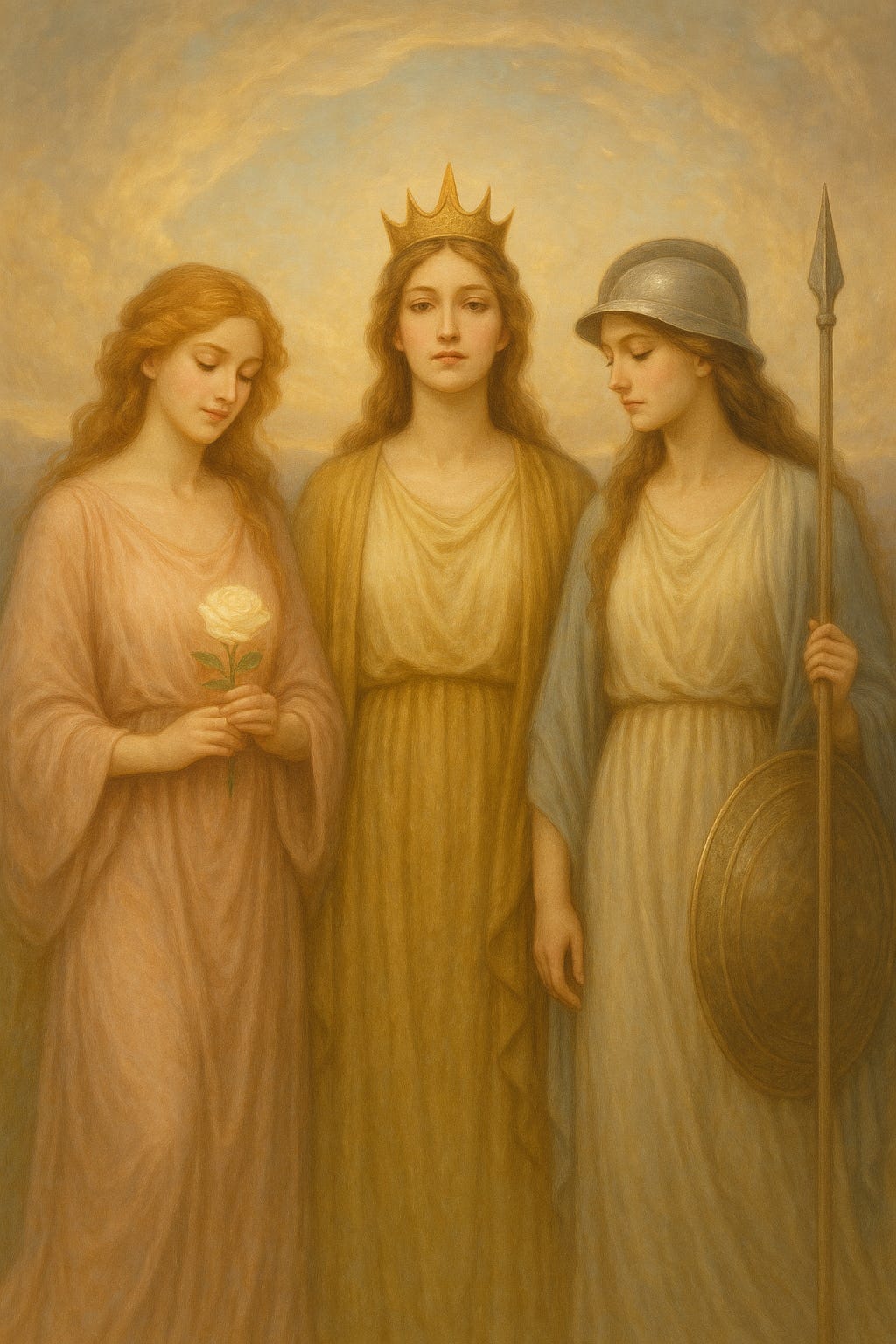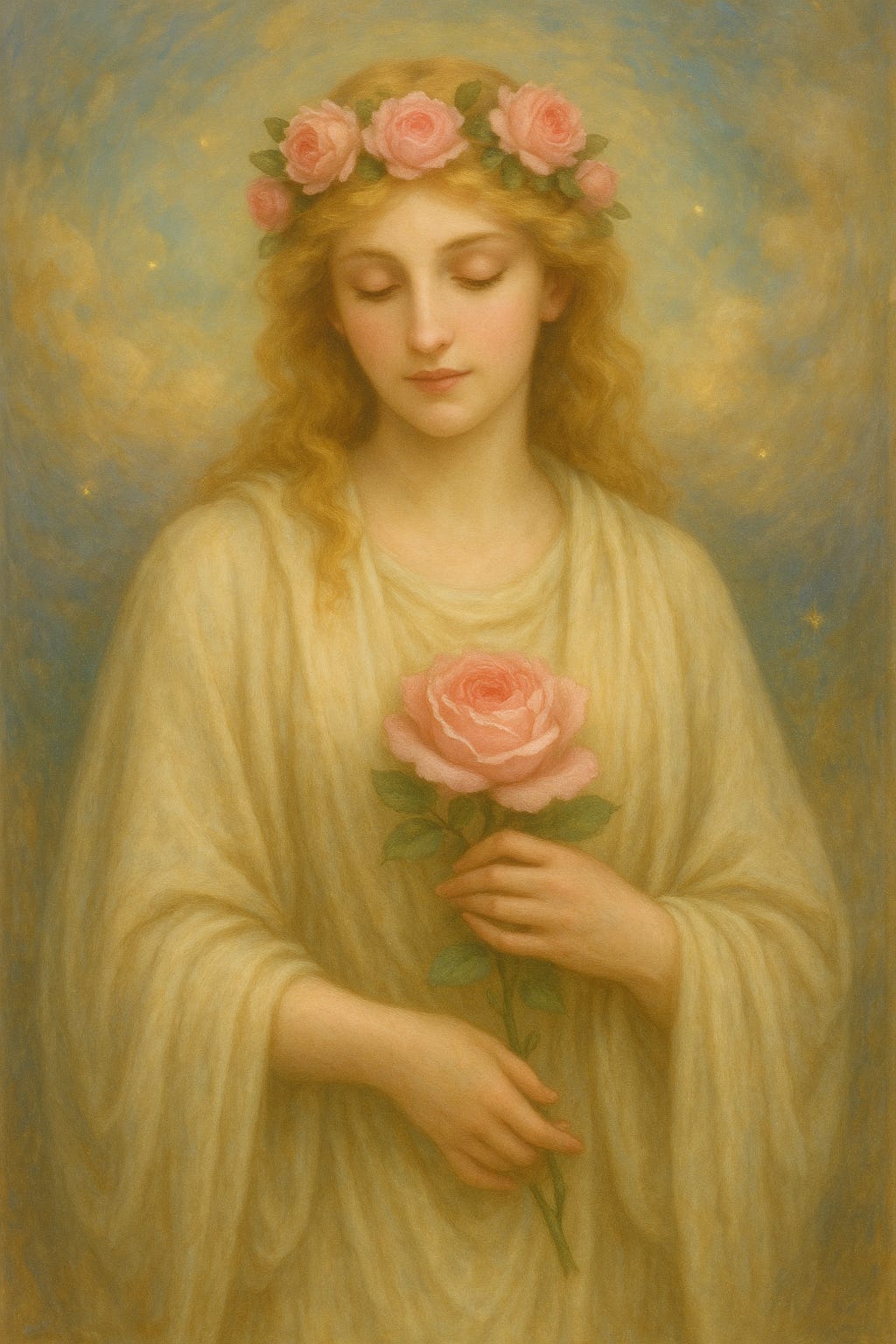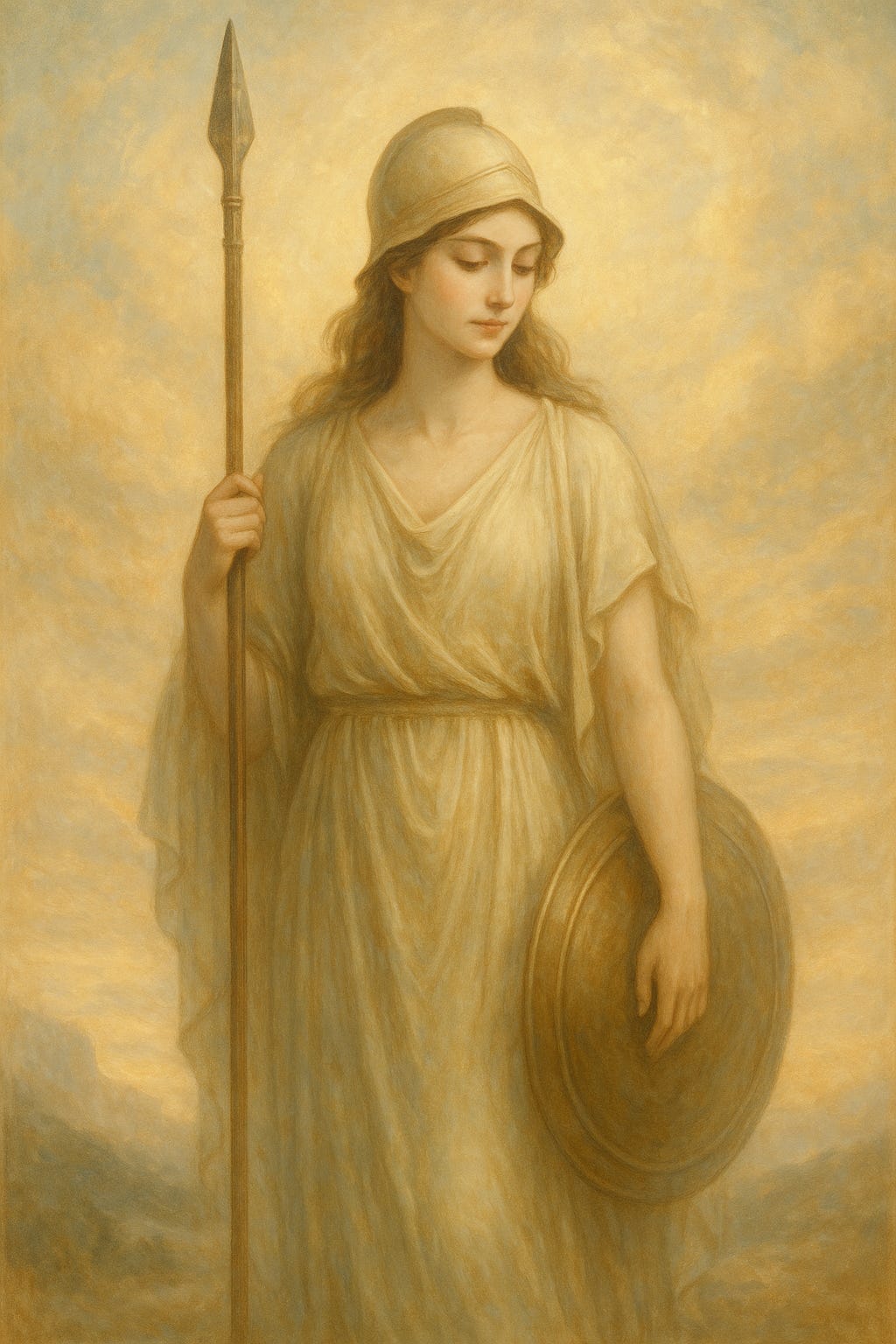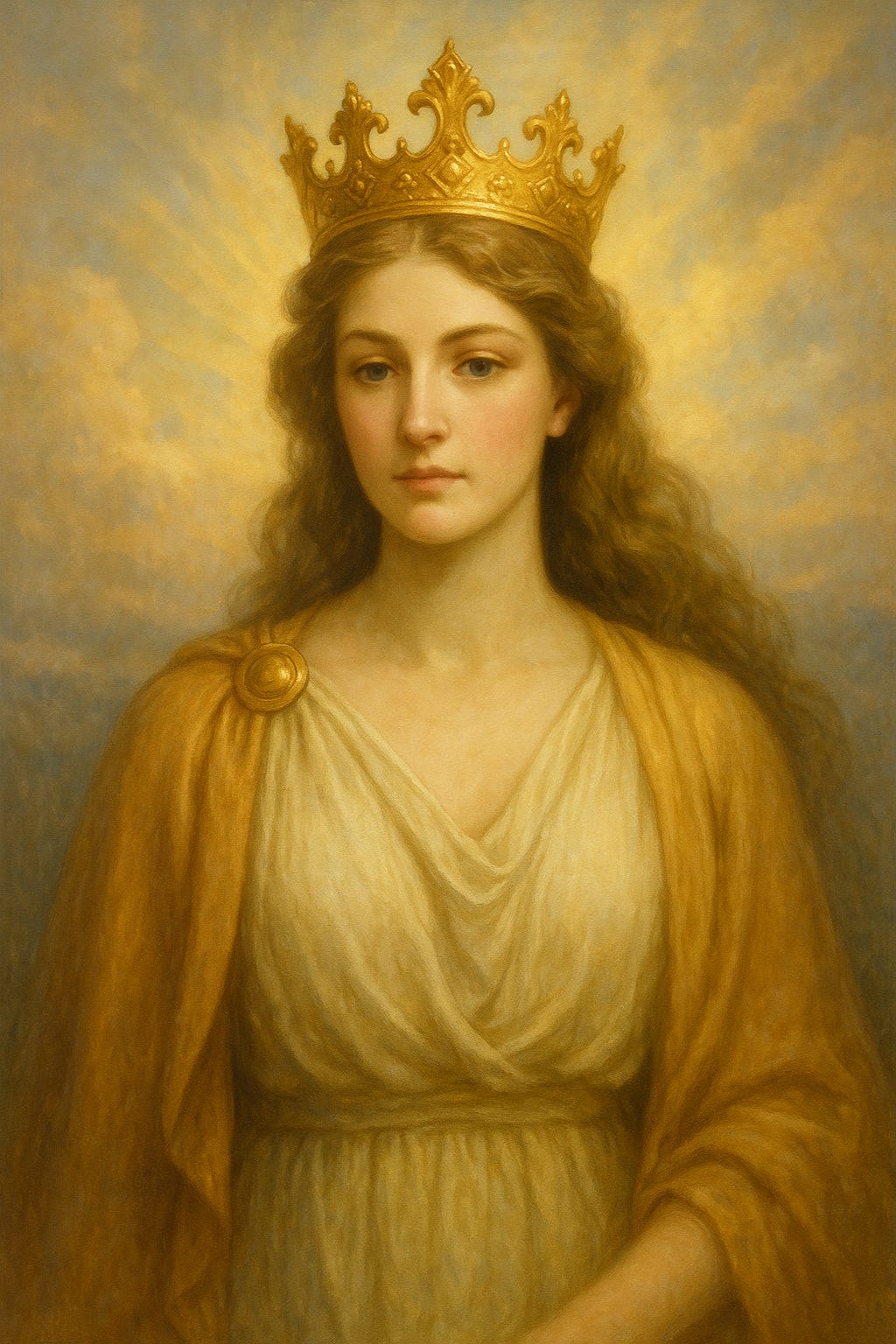The Chronicles of the Sky-Veil: Chapter VII
The Pathways of Light

The Chronicles of the Sky-Veil is a mythopoetic journey through the silence between worlds.
In The Chronicles of the Sky-Veil, the nameless man on the Journey Across the Sky-Veil writes his journal in the empty book given to him mysteriously in a satchel while sleeping. He reveals his thoughts as the Journey unfolds. In The Chronicles, the reader discovers the man’s hidden thoughts and the remembrances transforming him from a wanderer to an heir of the Majestic Highlands.
This is not sentimentality or mere imagination. It is not theology or philosophy. It is the story of the nameless man’s remembrance-in-the-world—told in myth, rooted in mystery. His is a journey from the Grey-Beneath to the Highlands of Majesty, through rose and flame, shield and crown.
From the Nameless Man’s Chronicles of the Sky-Veil1
There were moments in the journey across the Sky-Veil when the soul had a sense of understanding what cannot be fully known. Beneath the canopy of time, as the golden fields trembled with morning light, I began to see that existence was not only lived but given—unassuming and glancing, like dew on leaves under the gleam of rosy dawn’s throne.
Though I spoke of insight and awakening, these were often but shadows of a deeper alethic revealing. The world itself seemed to whisper of purpose and form, though few times did I pause long enough to hear it. It is Aphrodite who first drew near—the gentle hypostatic herald2 who brought the shimmering Veil close to my heart. Through her presence, I began to intuit that love was not merely affection but the very nearness3 of a beauty not born of this world. Aphrodite was not a being but a shimmer of the Being-ness of beauty and love. It was she as the rose-bearer4 who invited me to step back from immediate distractions, to breathe in the fragrance of what lies hidden but sensed, to recognize the appearance of the appearing.5

This movement of stepping back—of reflection—was not merely human. It was the divine nearness hidden within the soul. As Aphrodite glided across the mirror-lake of meaning, she opened pathways where my soul could remember6 what it always knew but had forgotten: that time was a clearing—where what was, what is, and what calls to be could dwell together, and that meaning was not constructed, but uncovered.
Yet beauty alone did not suffice. There were moments—flashes—that demanded reckoning. It was Athena who confronted me with these on the path. With a flame in hand and a blade at her side, she marked the decisive hours: moments when the eternal broke into the temporal day. Her presence amidst these necessary trials inspired but also revealed. She guided with a glitter of light, not to overwhelm, but to compel me to see clearly. These were not gentle intuitions. They were sparks from beyond the Veil, bearing weight and fire. Through Athena, I experienced what cannot be explained yet cannot be denied.

Hera, the Sky-Crowned, held the realm in which these two currents met. She was the glint of majesty, not through conquest, but through order—the luminous architecture of Being in the world. In her radiance, the fragmented symbols of beauty and wisdom found their shape. Hera did not force. She reigned. The structures of remembrance, the longing for a home not yet seen, the ache to belong to a story greater than oneself—these were her gifts. Her sparkle drew the traveler into the greater pattern, the veiled lineage, the Kingdom not built by hands.
Together, the three were not the revealed but “the revealing.” The Sky-Veil was their language. And within its woven threads, I began to sense that all moments—those of Aphrodite’s reflection, of Athena’s fire, and of Hera’s order—were not isolated. They spiraled toward one another. They drew my soul toward the nearness of Being behind the Veil.
Some will say that these signs and sensations were natural, part of any human’s ascent toward self-awareness. And they were. But they were also more. The heralds did not merely symbolize; they gleamed with the light of a greater domain. What glimmered through them was not only a deeper part of nature—it was the brush of something other, something that could not be named without losing it. And yet, it drew near.
One might ask whether the stories about these encounters—these figures and symbols—were themselves distortions. But to that the Sky-Veil answers: what if they were not distortions but conduits of the revealing of Being? What if the path itself was shaped in the form the eternal on the far side of the Veil chose to take? They were not the corruption of our subjective imagination but the purity of revelation beyond the Veil.
The tale that unfolded here was such a conduit. It was my soul's account of the heralds—of Aphrodite, Athena, and Hera—as they appeared, and still appear, to those who walk the soft pathways of the Sky-Veil. Their hypostatic presence was not to be idolized but followed as soft alabaster lights marking the path of the golden thread. Their sheen was not for spectacle but for remembrance.
Let the traveler understand: the journey was not to escape the world, but to receive it as it had always meant to be received. The Veil did not inhibit—it disclosed the heralds and hid them only to reappear again. It danced between our forgetfulness and the remembrance we once knew. And through that dance, I was not merely walking—I was being drawn.
Enjoy “The Ancients of the Sky-Veil” from my album The Sky-Veil, available on my music site.
Lyrics ©Walter Emerson Adams. Music and vocals by Suno ©Walter Emerson Adams.
Aphrodite, she of Sea and Smile Who dances on the waves at rosy dawn With laughter, moves in secret through the stars Divine in love across the waters drawn She watched the man with sorrow, care, and heart Athena, she of Light and Flashing Eyes The maiden of high minds, a voice that spans To those who hear, she whispers wise and clear To those who hear, with mortal minds that can She led the man with signs unseen, revered Hera, she of Crown and Gold Ox-Eyes In majesty arises tall and veiled No longer sitting on the ancient thrones But walks through temples, ruins, vanished, paled She bears the weight of kingdoms yet to come Athena, Hera, Aphrodite In hush beneath the Sky-Veil’s dome of grey The three emerged once more to guard and guide Dynastic bearers, shepherds through the day To guide the man to mountain peaks and flames
✦ Sky-Veil - The threshold of Being in this mythopoetic cosmology, representing the veil between the mundane, flat world of day-to-day existence and the enchanting retrieval of Being—between symbol and meaning, longing and fulfillment. The Sky-Veil refers to this as moving from “forgetfulness” (flat world) to “remembrance” (enchantment gleaming around the divine we have always known but forgotten). It is across the Sky-Veil that hypostatic heralds of Being—embodied symbolically by the goddesses—shimmer, and through which the soul journeys in mythic wonder toward divine encounter. Saints dwell beyond the veil in the Highlands of Majesty and the contemplative Grove Beyond; the goddesses, as “hypostatic emergences” foreshadowing divine virtues, herald through the liminal “space” in the world we encounter.
✦ Hypostatic Heralds - Figures who bear the presence of a hypostatic (essential) form. The goddesses do not possess Being as beings, but they announce its substantive varied meanings as it gives itself in the world—beauty, wisdom, majesty. As heralds, they alert the soul through their glint to a deeper contemplation of divine attributes. They harken through shimmers to what is real in effect and presence, though they are not personal subjects or metaphysical beings.
✦ Nearness - Not spatial proximity but a mode of disclosure—the drawing-near of Being itself in moments of unveiled significance. It conveys a presence that is not fully present, a proximity that is not measurable, but rather experienced in the heart’s intuition and the soul’s readiness.
In Heideggerian terms, nearness belongs to the mystery of Being’s self-showing (aletheia). It is the threshold where the veil stirs but does not part, where the divine does not arrive as an object but becomes luminously felt. Nearness is not what we possess but what approaches us, like the breeze that carries meaning without language. It is the quiet shimmer before revelation—the silent resonance that moves before the Word.
In the Sky-Veil, nearness is the air the wanderer breathes when the heralds pass by, the fragrance of the rose before it is seen, the warmth of the flame before it is touched. It is the grace of Being brushing against the soul, unseizing, ungraspable, yet unmistakably there.
✦ Aphrodite’s Rose - Within the Sky-Veil, Aphrodite’s Rose blooms as the first shimmering herald of divine beauty—the pure, unbidden revealing of forgotten Being that stirs the soul toward remembrance. It is neither an earthly flower nor a heavenly apparition, but the liminal threshold where divine beauty descends to meet the exile of the Grey-Beneath.
The Rose neither demands nor conquers; it reveals. In its fragrance, color, and form, it bears the silent proclamation that Being is beautiful, that existence is a gift, and that the exiled soul is still beloved. Aphrodite, as the keystone of the archway leading into the Sky-Veil, breathes forth the Rose as her first and most tender offering, a whisper of the divine beyond the Veil.
Those who hold Aphrodite’s Rose near their heart do not simply see beauty or merely understand its definition; they are wounded by it—wounded into longing, wounded into the journey home. It is the gentle beginning of awakening, the call to cross the Veil and return to the fullness of their forgotten heritage.
✦ Appearance of the Appearing - The moment when the world is no longer merely seen but begins to reveal itself. Not the object itself, nor the act of perception alone, but the shimmering instant when what is steps forth from concealment—not as final truth, but as invitation.
In the Sky-Veil: It is the first stirring of nearness—when a thing, a moment, or a presence does not merely show itself, but shows that it is showing. This is not a spectacle but an unveiling—a path opening beneath the surface of the familiar. It is a field of flowers in the half-light suddenly blooming with meaning in rosy dawn, not because we see them, but because they let themselves be seen.
The appearance of the appearing is a gift from the Veil—it is Being drawing near. It comes not to those who grasp, but to those who dwell. It is not the pursuit of wisdom but the love of wisdom. The wanderer in the Sky-Veil learns to wait for this glimmer, to listen not for the sound, but for the silence that lets the sound be heard.
It is the threshold moment before understanding, before speech—when one is pierced by what shines forth without yet knowing why.
✦ Remember/Remembrance - To remember is not to recall facts or events, but to stand again in the nearness of what is.
In the Sky-Veil, Remembrance is not the retrieval of memories from a personal or collective unconscious. Rather, it is the unconcealing of what has always been—the letting-be of Being—in the manner of Heidegger’s Ereignis, or the event of disclosure. To remember is to dwell where Being has touched us and where the meaning of one’s path begins to shine through the fog of exile.
The wanderers of the Dark Forest or Grey-Beneath do not lack recall; they lack remembrance of what is near. And when a herald shines, it is not a call to novelty or “hidden” knowledge, but to recognize presence. One does not learn the meaning of the Sky-Veil; one remembers it. That is to say, one stands again in the unveiling light of what was always there, waiting.
Remembrance, in the Sky-Veil, is a step beyond the calculative, syllogistic metaphysical and into the poetic, where the world is no longer a stockpile of objects to be measured and explained but a revealed place of meaning.



